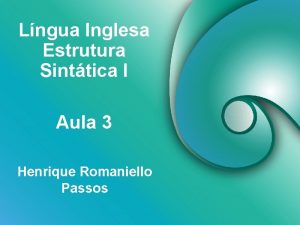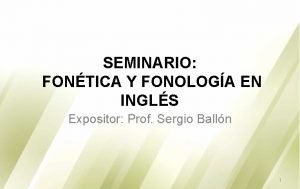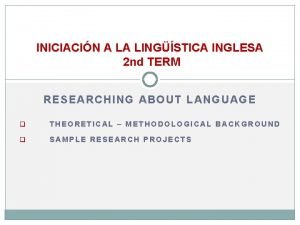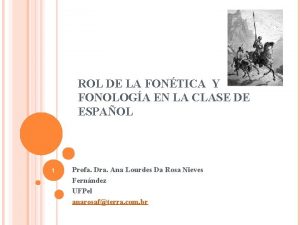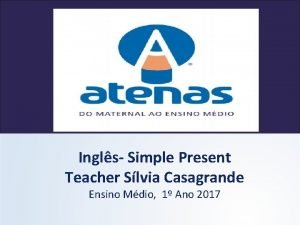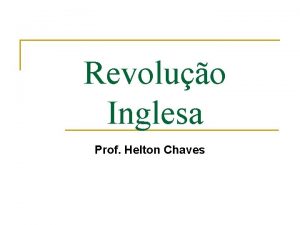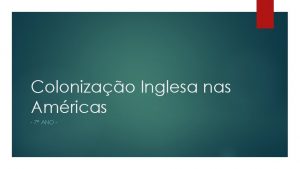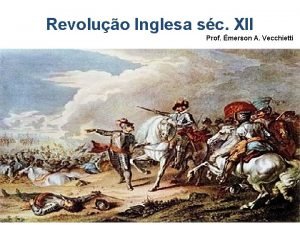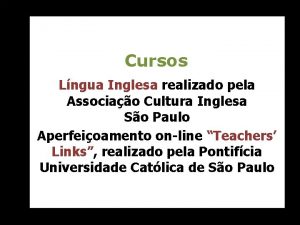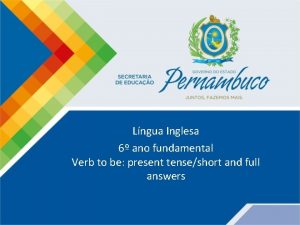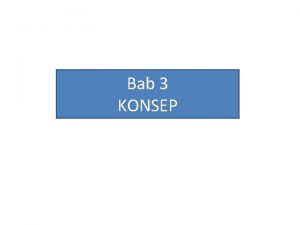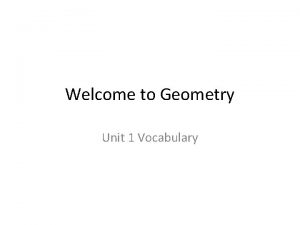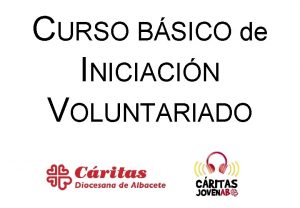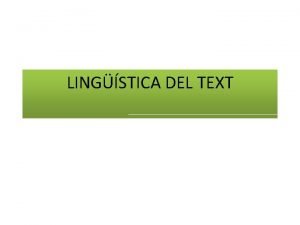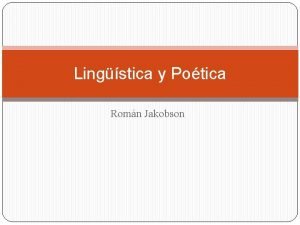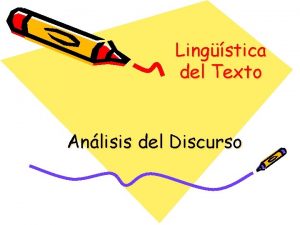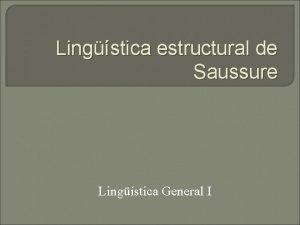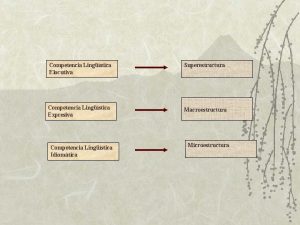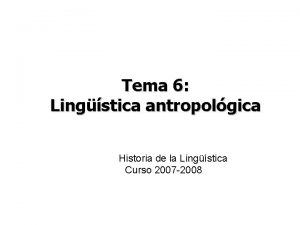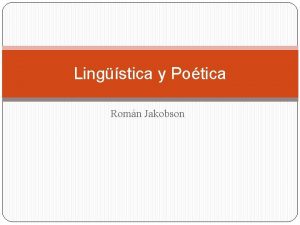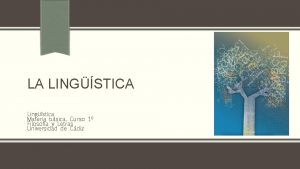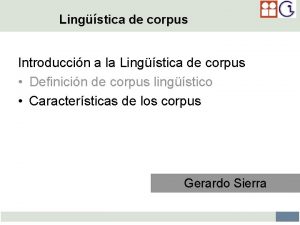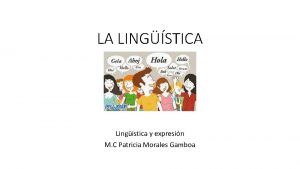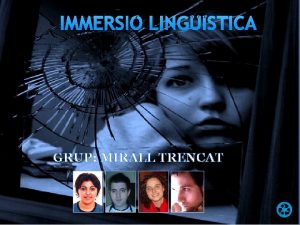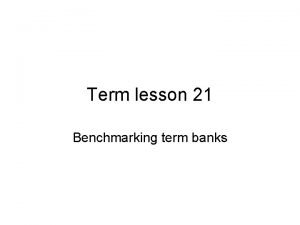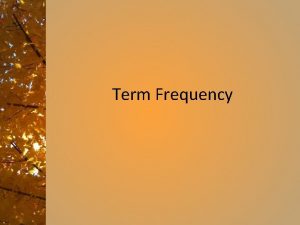INICIACIN A LA LINGSTICA INGLESA 2 nd TERM



























- Slides: 27

INICIACIÓN A LA LINGÜÍSTICA INGLESA 2 nd TERM RESEARCHING ABOUT LANGUAGE q THEORETICAL – METHODOLOGICAL BACKGROUND q SAMPLE RESEARCH PROJECTS

THEORETICAL – METHODOLOGICAL BACKGROUND THE STAGES OF RESEARCH q PLANNING THE RESEARCH q CARRYING OUT THE RESEARCH q DRAWING CONCLUSIONS ABOUT THE RESEARCH

PLANNING THE RESEARCH 1. Select a topic 2. Give reasons for the choice 3. Decide type of research 4. Specify main objectives 5. Outline methodology 6. Look for data and collect a corpus of examples 7. Look for sources of information and study them 8. Formulate hypotheses and classify them

PLANNING THE RESEARCH 1. Selecting a topic ‘Doability’ 2. Justifying the choice (reasons) Motivation (Personal) Interest

PLANNING THE RESEARCH 3. Deciding type of research Theoretical vs Applied (‘practical’) Single structure/unit vs Comparison of structures/units Monolingual vs Contrastive 4. Specifying main objectives 5. Outlining methodology

PLANNING THE RESEARCH 6. Looking for data and collecting a corpus of examples A corpus must be: homogeneous representative comprehensive • geographical variety (‘dialect’) • temporal variety (‘syncrony’) • medium • register

PLANNING THE RESEARCH q (ELECTRONIC) CORPORA British National Corpus: http: //www. natcorp. ox. ac. uk/ Corpus Concordance English: http: //www. lextutor. ca/concordancers/concord_e. html Mark Davies – BNC: http: //corpus. byu. edu The Collins Cobuild Concordance and Collocations Sampler: http: //www. collins. co. uk/Corpus. Search. aspx Web. Corp: http: //www. webcorp. org. uk

PLANNING THE RESEARCH INTERNATIONAL CORPUS OF ENGLISH (ICE) TEXT CATEGORIES � � � � � � SPOKEN DIALOGUE Private direct conversations distanced conversations Public class lessons broadcast discussions broadcast interviews parliamentary debates legal cross-examination business transactions MONOLOGUE UNSCRIPTED spontaneous commentaries unscripted speeches demonstrations legal presentations SCRIPTED broadcast news broadcast talks speeches (not broadcast) � � WRITTEN NON-PRINTED Non-professional writing student untimed essays � � � � � � � student examination essays CORRESPONDENCE social letters business letters PRINTED INFORMATIONAL (LEARNED) humanities social sciences natural sciences technology INFORMATIONAL (POPULAR) humanities social sciences natural sciences technology INFORMATIONAL (REPORTAGE) press news report INSTRUCTIONAL administrative/regulatory skills/hobbies PERSUASIVE press editorials CREATIVE novels/stories

PLANNING THE RESEARCH 7. Gathering (reference) information Dictionaries Literature about morphosyntactic structure of English Books Journals Native informants / Questionnaires

PLANNING THE RESEARCH 8. Formulating and classifying hypotheses Questions leading to hypotheses: What sort of linguistic element are we going to describe? At what level of description should we classify the linguistic phenomenon under study? What do we know about its form? What do we know about its distribution? What do we know about its function? What do we know about its meaning?

Formulating and classifying hypotheses What sort of linguistic element are we going to describe? Grammatical category: Tense, Number, Comparison Morpheme: dis-, -un, -er Word (as ‘class’ / as single ‘lexical item’): Preposition, Noun; accident Phrase: Adjective Phrase, Verb Phrase; the concept of ‘Phrase’ Functional element: Subject, Modifier, Complement Clause / Sentence: Relative Clauses, Conditional Clauses, Compound Sentences

Formulating and classifying hypotheses At what level of description should we classify the linguistic phenomenon under study? Inflections: morphemic and word levels Adverbial clauses: clause and sentence levels Passive voice: Clause level: active vs passive clauses; intensive vs passive; syntactic constituents of passives Phrase level: the passive verb phrase; restrinctions in terms of modifications; passive VPs and –ed Adjective Phrases Lexical level: Verbs accepting/rejecting passive voice Word/Morphemic level: the passive ‘morpheme’; passive auxiliaries Etc.

Formulating and classifying hypotheses What do we know about its form? Morphemes (Derivational / Inflectional): Spelling Pronunciation Words: Spelling / Pronunciation Stress Structure: simple/complex/compound Inflections Word-formation potential Phrases: Formal realization of constituents Clauses: Formal character: Tensed vs Non-tensed clauses (Finite / Non-Finite) Formal realization of constituents Presence/Absence of subordinators Relationships between verb forms in main and subordinate clause

Formulating and classifying hypotheses What do we know about its distribution? Which (other) elements are affected How do they tend to co-occur? What restrictions apply?

Formulating and classifying hypotheses What do we know about its function? What do we know about its meaning? What the element ‘does’ both syntactically and semantically: communicative force Morphemic level: number, past Clause: Passive vs active, coordination vs. subordination

THEORETICAL – METHODOLOGICAL BACKGROUND THE STAGES OF RESEARCH q PLANNING THE RESEARCH q CARRYING OUT THE RESEARCH q DRAWING CONCLUSIONS ABOUT THE RESEARCH

CARRYING OUT THE RESEARCH 1. Identification and isolation of the corpus 2. Analysis and study of the corpus 3. Description and classification of results

Identification and isolation of the corpus Included examples Marginal examples Excluded Examples

Identification and isolation of the corpus THE VERB PLAY 1. 2. 3. 4. 5. 6. 7. They needed loving. Robots can sing and PLAY games, but they can't love. Only the Sta to entertainment, radio and TV can also PLAY a vital role in advancing the aims of ed g without batteries. It can retrieve and PLAY audio from a CD-ROM in addition to text story and writing and reading. I wrote a PLAY and directed it on our garden lawn. I AMLET: Follow him, friends. We'll hear a PLAY tomorrow. (Aside to the PLAYER, who is t be planted along roads and in parks and PLAY facilities for children should be create Car Park. Skittle Alley. Beer Garden and PLAY Area. Room available for all types of fu ic Development Committee hasn't always PLAYED the game, you never know wh 9. watched the television of an evening. PLAYED games and records and telephoned people, 10. probably the most PLAYED classical music in the world 11. This attractive and well- PLAYED recital is given on an Erard piano made 12. r does the loud ovation after a well- PLAYED, but not very insightful account of the 8.

Identification and isolation of the corpus INTENSIVE CLAUSES He was silly. His eyes appeared enormous. He went mad. She had run naked. The book appeared published He went there. He was worried. He appears in chains. The women were marched naked. He went fast.

CARRYING OUT THE RESEARCH 2. Analysis and study of the corpus Begin with a small number of examples Analyse and classify them in relation to all hypotheses Outline preliminary conclusions Include new examples (if necessary)

Analysis and study of the corpus Analysis and classification of examples in relation to all hypotheses ITEM Example of the item 1. FORM (1 a). . . . (1 b). . . . (1 c). . . . 2. DISTRIBUTION (2 a). . . . (2 b). . . . (3 c). . . . 3. FUNCTION/MEANING (3 a). . . . (3 b). . . . (3 c). . . .

Analysis and study of the corpus ITEM : ACCIDENT Example: Accidents, however, usually take us by surprise. 1. FORM (1 a) It is a complex word, formed with a base and a derivational suffix: False: *Accid + ent (1 b) It shows number contrast : True ‘Accidents usually take us by surprise’ ‘An accident usually takes us by surprise’. 2. DISTRIBUTION (2 a) It can take all type of determiners: (Partly) true: The/These/His/Some/Many/No/All/Ø accidents usually take us by surprise An/The/This/His accident usually takes us by surprise. But: *Much accident(s); Ø/All accident 3. FUNCTION/MEANING (3 a) etc.

Description and classification of results From Examples (Data) to Hypotheses (Description/Theory) The description should follow the order of the analysis. ITEM Example 1 Example 2 ITEM Example 3 1. FORM (1 a). . . . . . . . . . . . . . (1 b). . . . . . . . . . (1 c). . . . . . . 2. DISTRIBUTION (2 a). . . . . . . . . . . . . . (2 b). . . . . . . . . . (3 c). . . . . . . 3. FUNCTION/MEANING (3 a). . . . . . . . . . . . . . (3 b). . . . . . . . . . (3 c). . . . . . . HYPOTHESES ABOUT ITEM 1. FORM (1 a). . . . (1 b). . . . (1 c). . . . 2. DISTRIBUTION (2 a). . . . (2 b). . . . (3 c). . . . 3. FUNCTION/MEANING (3 a). . . . (3 b). . . . (3 c). . . .

THEORETICAL – METHODOLOGICAL BACKGROUND THE STAGES OF RESEARCH q PLANNING THE RESEARCH q CARRYING OUT THE RESEARCH q DRAWING CONCLUSIONS ABOUT THE RESEARCH

DRAWING CONCLUSIONS How does the item under study behave as regards form/distribution/function/meaning, according to examples examined? The question of ‘frequency’. How can we define the item? Are there aspects which are still difficult to describe or explain and which deserve further investigation?

DRAWING CONCLUSIONS RECONSIDERING HYPOTHESES How far do our conclusions match initial hypotheses: completely/partially/at all? Can we explain the differences? Were our hypotheses wrong? - Is our corpus of examples too small to reflect real use? - Are we using a representative corpus?
 Henrique inglesa
Henrique inglesa Puntos de articulacion en aymara
Puntos de articulacion en aymara Lingua inglesa
Lingua inglesa Gramtica inglesa
Gramtica inglesa Consonantes oclusivas
Consonantes oclusivas Lingua inglesa
Lingua inglesa Guerra das rosas
Guerra das rosas A conquista colonial inglesa resultou no estabelecimento
A conquista colonial inglesa resultou no estabelecimento Mesa en ingles
Mesa en ingles Revolução inglesa
Revolução inglesa Cultura inglesa tatuapé
Cultura inglesa tatuapé Lingua inglesa
Lingua inglesa Position to term rule worksheet
Position to term rule worksheet Term to term rule example
Term to term rule example Term-to-term rule
Term-to-term rule Difference between long term and short term liabilities
Difference between long term and short term liabilities Term to term rule
Term to term rule Quadratic sequence
Quadratic sequence Long term memory vs short term memory
Long term memory vs short term memory Long-term liabilities examples
Long-term liabilities examples Short term goal
Short term goal Example of short term human resources
Example of short term human resources Expand a+bc'+abd'+abcd to minterms and maxterms
Expand a+bc'+abd'+abcd to minterms and maxterms Long medium and short term planning in primary schools
Long medium and short term planning in primary schools Short term and long term cash forecasting
Short term and long term cash forecasting Komprehensi dan ekstensi
Komprehensi dan ekstensi Is a ray an undefined term
Is a ray an undefined term 2020 revised curriculum and assessment plans grade 6
2020 revised curriculum and assessment plans grade 6
